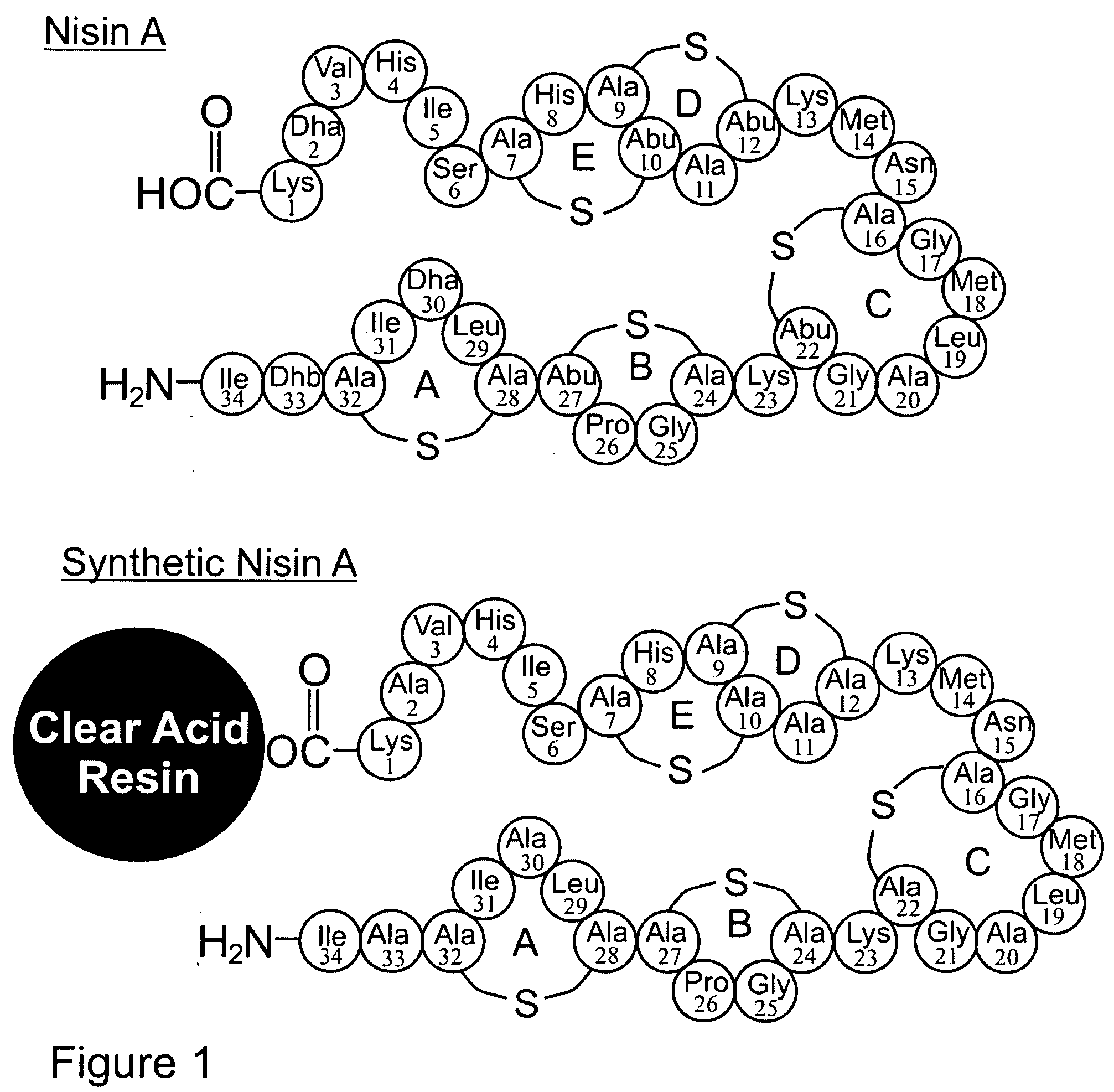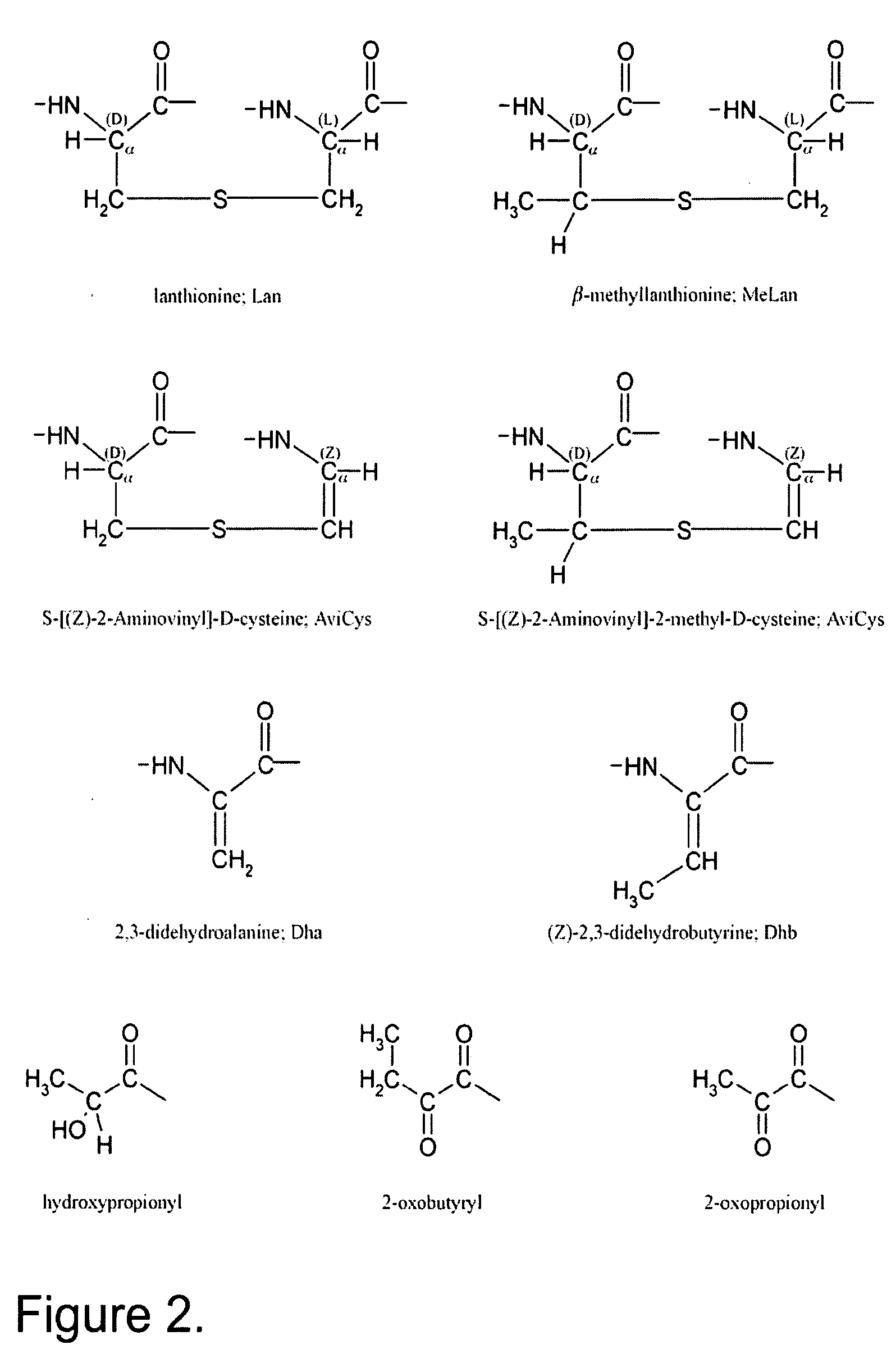Differentially protected orthogonal lanthionine technology
a technology of orthogonal lanthionine and orthogonal lanthionine, which is applied in the direction of peptide/protein ingredients, bulk chemical production, peptide sources, etc., can solve the problems of not being able to obtain these molecules in sufficient quantities, not being able to test and commercialize, and not being able to achieve the cost effective amount to enable testing and commercialization,
- Summary
- Abstract
- Description
- Claims
- Application Information
AI Technical Summary
Benefits of technology
Problems solved by technology
Method used
Image
Examples
example 1
Synthesis of Differentially Protected Orthogonal Lanthionines
A. Synthesis of Fmoc-Cys
[0124] Fmoc-protected cysteine (FIG. 3, structure B) was synthesized in a two step sequence from L-cystine as outlined in FIG. 4. Sodium carbonate (4.6 g, 43.6 mmol) and L-cystine (5.0 g, 20.8 mmol) were dissolved in water (200 mL). The resulting solution was cooled to 10° C. FmocCl (11.85 g, 45.8 mmol) was dissolved in dioxane (80 mL), and the resulting solution was added dropwise to the aqueous solution of L-cystine. The solution was stirred for 2 h at 10° C. and allowed to gradually warm to room temperature. A thick white precipitate was obtained that was filtered onto a sintered glass funnel. The product was triturated with diethyl ether (50 mL) and dried in vacuuo for 2 d. N,N′-Bis(Fmoc)-L-cystine (14.0 g, 98% yield) was obtained as a white powder.
[0125] N,N′-Bis(Fmoc)-L-cystine (12.0 g, 17.5 mmol) was dissolved in methanol (300 mL). Granular zinc (12.0 g) was added to this solution and the...
example 2
Synthesis of Lantibiotic Nisin A Analog Using Lanthionines 1 and 2
A. Solid Phase Peptide Synthesis of the Nisin A Analog
[0135] A Nisin A analog [SEQ ID NO: 2] is synthesized in accordance with the invention as outlined below. The analog contains alanine substitutions for the dehydrobutarine at position 33 and dehydroalanines at position 30 and 2. Considerable evidence indicates that this will have no significant effect on the spectrum of activity and potency of the product relative to native Nisin A (Kuipers et al., (1996); Devos et al. (1995), Molecular Microbiology 17, 427-437; Sahl et al. (1995), European Journal of Biochemistry 230, 827-853; Bierbaum et al. (1996), Applied and Environmental Microbiology 62, 385-392).
[0136] Unless otherwise indicated, all protocols are standard Fmoc SPPS methodology reported in the literature. White (2003) Fmoc Solid Phase Peptide Synthesis, A practical Approach, Oxford University Press, Oxford. Nisin A is synthesized from its carboxy terminu...
example 3
Structural and Biological Analysis of the Purified Nisin A Analog
A. Bioassay of the Nisin A Analog
[0161] The lantibiotic thus synthesized and purified as shown in Examples 1 and 3 are aliquoted and lyophilized. The resulting product is weighed and the final yields calculated. The biological activity of the Nisin A analog is determined by a deferred antagonism assay, known in the art, which permits the determination of the minimum inhibitory and bacteriocidal concentrations of the Nisin A analog (Hillman et. al. (1984), Infection and Immunity 44, 141-144; Hillman et. al. (1998), Infection and Immunity 66, 2743-2749). Comparison to native Nisin A to enables the determination of the respective specific activities. The bioassay is conducted as follows:
[0162] Samples (20 μl) of fractions to be tested for Nisin A activity are serially diluted 2-fold using acetonitrile: water (80:20) in 96 well microtiter plates. Concentrations range from 20 to 0.08 μg / mL. An overnight culture of the M...
PUM
 Login to View More
Login to View More Abstract
Description
Claims
Application Information
 Login to View More
Login to View More - R&D
- Intellectual Property
- Life Sciences
- Materials
- Tech Scout
- Unparalleled Data Quality
- Higher Quality Content
- 60% Fewer Hallucinations
Browse by: Latest US Patents, China's latest patents, Technical Efficacy Thesaurus, Application Domain, Technology Topic, Popular Technical Reports.
© 2025 PatSnap. All rights reserved.Legal|Privacy policy|Modern Slavery Act Transparency Statement|Sitemap|About US| Contact US: help@patsnap.com



